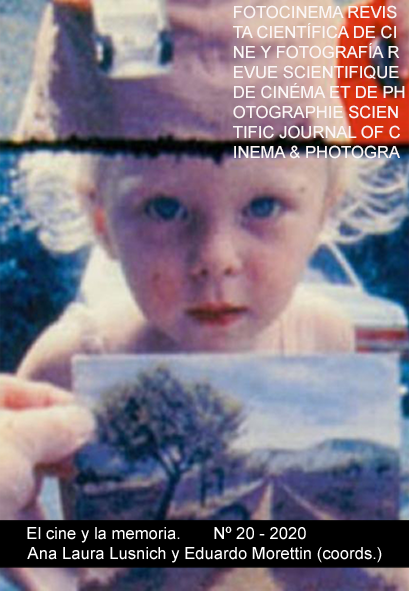Match Point (Allen, 2005): Regarding Patricia Highsmith’s Tom Ripley
DOI:
https://doi.org/10.24310/Fotocinema.2020.v0i20.7616Keywords:
Intertextuality, Preexisting Music, Woody Allen, Patricia Highsmith, Anthony MinghellaAbstract
Recognized as one of the most prolific directors in the last 30 years, Woody Allen presented his movie Match Point in 2005. The main characteristic that defines it is the behavior of its protagonist, Chris Wilton, a retired professional tennis player who arrives in London with great aspirations. This upstart and amoral character seems to have emerged from the novels of Patricia Highsmith, more specifically from her most famous character, Tom Ripley. Both protagonists share common links: ambition, murders, crimes without punishment, easy to adapt to the environment, lack of morality... The aim of this article is to address the parallels and connections between Match Point and The talented Mr. Ripley (Highsmith, 1955), both in the novel and in his film adaptations, focusing mainly on the film that Anthony Minghella presented in 1999 under the homonymous title of the novel by Patricia Highsmith, highlighting the use of music as a fundamental narrative resource.
Downloads
Metrics
Publication Facts
Reviewer profiles N/A
Author statements
Indexed in
-
—
- Academic society
- N/A
- Publisher
- Universidad de Málaga
References
Allen, W. (2005). Match Point. Guion cinematográfico. Madrid: Espiral.
Chion, M. (1993). La audiovisión. Introducción a un análisis conjunto de la imagen y del sonido. Barcelona: Paidós.
Falsetto, M. (2013). Anthony Minghella. Interviews. Mississippi: University Press of Mississippi.
Freud, S. (2017). Obras completas. Ebook, Oregan Publishing
Genette, G. (1989). Palimpsestos. La literatura en segundo grado. Madrid: Taurus.
Highsmith, P. (1993). A pleno sol (The talented Mr. Ripley). Barcelona: RBA Editores.
Kuz, M. (2011). Justice and the Western Perception of Dostoievsky: Woody Allen’s Crimes and Misdemeanors and Match Point. APSA 2011 Annual Meeting Paper. Recuperado de https://ssrn.com/abstract=1903053
Minguella, A. (2000). The talented Mr. Ripley: Screenplay. Londres: Methuen Drama.
Motazedian, T. (2017). To key or not to key: Tonal design in film music (Tesis doctoral). New Haven: Universidad de Yale.
Poluyko, K. (2011). Alternative Music: Jazz and the Performative Resignification of Identity in Anthony Minghella’s The Talented Mr. Ripley. The Journal of Men’s Studies, Vol. 19, Nº 1, MSP.
Rivera León, L. (2017). ¿Crimen sin castigo? Sobre la primera incursión de Woody Allen en el universo moral de Dostoievski. En Miradas intersubjectivas en la filosofía actual marzo 2016. Valencia: Sociedad de Filosofía del País Valenciano.
Ruiz de Loizaga Martín, M. (2016). Crimen y castigo y Match Point. Más allá del azar. En Mundo Eslavo 15. Granada: Universidad de Granada.
Sanchez Noriega, J.L (2000). De la literatura al cine. Barcelona: Paidós.
Shakespeare, W. (1980). Hamlet / Macbeth. Barcelona: Editorial Planeta.
Sófocles (1992). Edipo en Colono. Madrid: Ediciones Clásicas.
Steblin, R. (1995). Historia de la caracterización de las tonalidades en el siglo XVIII y comienzos del siglo XIX. En Quodlibet nº 33 octubre 2005. Alcalá de Henares: Universidad de Alcalá.
Tchaikovsky, P.I. & Shilovsky, K. (1993). Eugene Onegin. Londres: Richard Schauer Music Publishers.
Wilson, A. (2010). Beautiful shadow: A life of Patricia Highsmith. Londres: Bloomsbury Publishing Plc.
Downloads
Published
How to Cite
Issue
Section
License
All contents published in Fotocinema Revista científica de cine y fotografía are protected under the Creative Commons Attribution-NonCommercial-ShareAlike 4.0 International (CC BY-NC-SA 4.0) license. All about this license is available in the following link: <http://creativecommons.org/licenses/by-nc-sa/4.0>
Users can copy, use, redistribute, share and exhibit publicly as long as:
- The original source and authorship of the material are cited (Journal, Publisher and URL of the work).
- It is not used for comercial purposes.
- The existence of the license and its especifications are mentioned.
There are two sets of authors’ rights: moral and property rights. Moral rights are perpetual prerogatives, unrenounceable, not-transferable, unalienable, imprescriptible and inembargable. According to authors’ rights legislation, Fotocinema. Revista científica de cine y fotografía recognizes and respects authors moral rights, as well as the ownership of property rights, which will be transferred to University of Malaga in open access. The property rights are referred to the benefits that are gained by the use or the dissemination of works. Fotocinema. Revista científica de cine y fotografía is published in an open access form and it is exclusively licenced by any means for doing or authorising distribution, dissemination, reproduction, , adaptation, translation or arrangement of works.
Authors are responsable for obtaining the necessary permission to use copyrighted images.














13.png)



